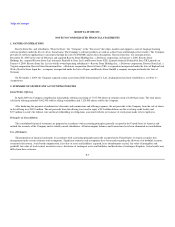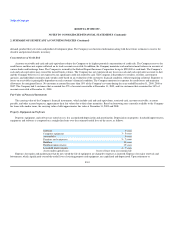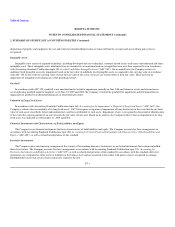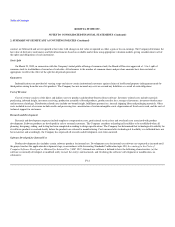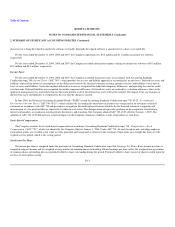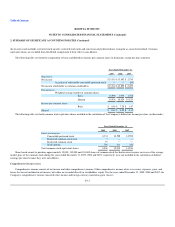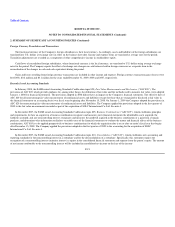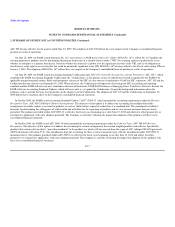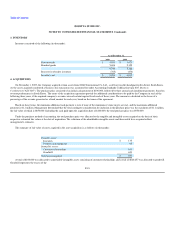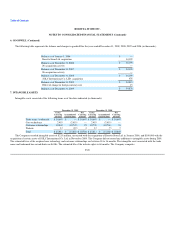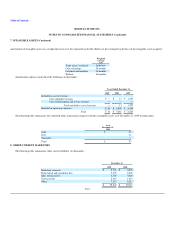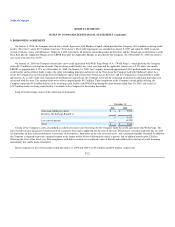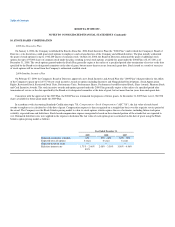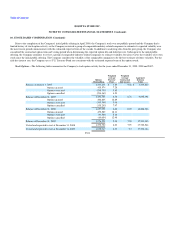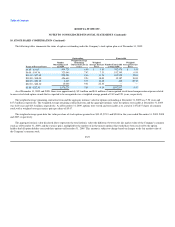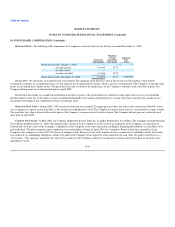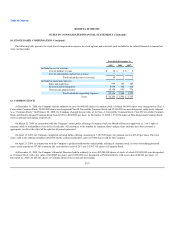Rosetta Stone 2009 Annual Report Download - page 93
Download and view the complete annual report
Please find page 93 of the 2009 Rosetta Stone annual report below. You can navigate through the pages in the report by either clicking on the pages listed below, or by using the keyword search tool below to find specific information within the annual report.
Table of Contents
ROSETTA STONE INC.
NOTES TO CONSOLIDATED FINANCIAL STATEMENTS (Continued)
2. SUMMARY OF SIGNIFICANT ACCOUNTING POLICIES (Continued)
ASC 855 became effective for the quarter ended June 30, 2009. The adoption of ASC 855 did not have any impact on the Company's consolidated financial
position or results of operations.
On June 12, 2009, the FASB issued Statement No. 167, Amendments to FASB Interpretation No. 46(R) ("SFAS No. 167"). SFAS No. 167 modifies the
existing quantitative guidance used in determining the primary beneficiary of a variable interest entity ("VIE") by requiring entities to qualitatively assess
whether an enterprise is a primary beneficiary, based on whether the entity has (i) power over the significant activities of the VIE, and (ii) an obligation to
absorb losses or the right to receive benefits that could be potentially significant to the VIE. SFAS No. 167 becomes effective for all new and existing VIEs on
January 1, 2010. The adoption of SFAS No. 167 will not have any impact on the Company's consolidated financial position or results of operations.
On June 29, 2009, the FASB issued Accounting Standards Codification topic ASC 105, Generally Accepted Accounting Principles ("ASC 105"), which
establishes the FASB Accounting Standards Codification (the "Codification") as the primary source of authoritative GAAP recognized by the FASB to be
applied by nongovernmental entities. Rules and interpretive releases of the SEC are also sources of authoritative GAAP for SEC registrants. ASC 105 and the
Codification become effective on September 30, 2009. When effective, the Codification will supersede all existing non-SEC accounting and reporting
standards and the FASB will not issue new standards in the form of Statements, FASB Staff Positions, or Emerging Issues Task Force Abstracts. Instead, the
FASB will issue Accounting Standards Updates, which will serve only to: (a) update the Codification; (b) provide background information about the
guidance; and (c) provide the basis for conclusions on the change(s) in the Codification. The adoption of ASC 105 and the Codification on September 30,
2009 did not have a material effect on the Company's consolidated financial statements.
In October 2009, the FASB issued Accounting Standards Update ("ASU") 2009-13, which amended the accounting requirements under the Revenue
Recognition Topic, ASC 605-25 Multiple-Element Arrangements. The objective of this update is to address the accounting for multiple-deliverable
arrangements to enable vendors to account for products or services (deliverables) separately rather than as a combined unit. The amendments establish a
hierarchy for determining the selling price of a deliverable and will allow for the separation of products and services in more instances than previously
permitted. The guidance provided within ASU 2009-13 is effective for fiscal years beginning on or after June 15, 2010 and allows for either prospective or
retrospective application, with early adoption permitted. The Company is currently evaluating the impact that adoption of this guidance will have on its
consolidated financial statements.
In October 2009, the FASB issued ASU 2009-14 which amended the accounting requirements under the Software Topic, ASC 985-605 Revenue
Recognition. The objective of this update is to address the accounting for revenue arrangements that contain tangible products and software. Specifically,
products that contain software that is "more than incidental" to the product as a whole will be removed from the scope of ASC subtopic 985-605 (previously
AICPA Statement of Position 97-2). The amendments align the accounting for these revenue transaction types with the amendments under ASU 2009-13
mentioned above. The guidance provided within ASU 2009-14 is effective for fiscal years beginning on or after June 15, 2010 and allows for either
prospective or retrospective application, with early adoption permitted. The Company is currently evaluating the impact that adoption of this guidance will
have on its consolidated financial statements.
F-17


